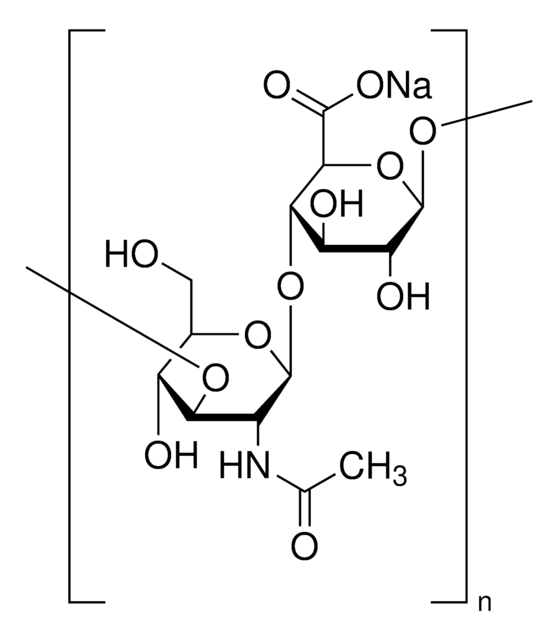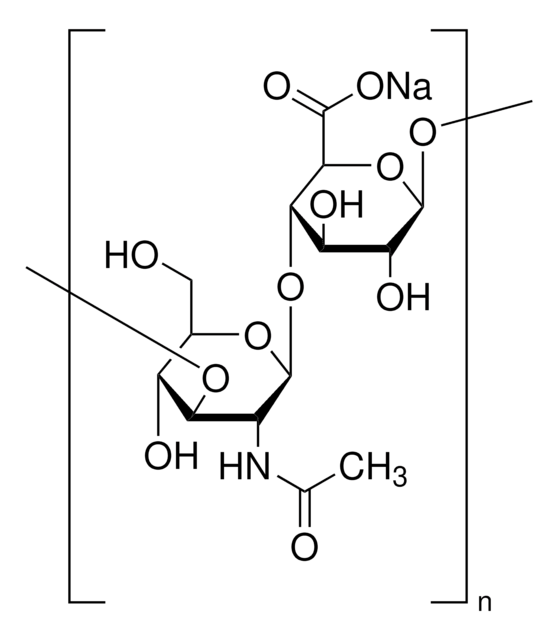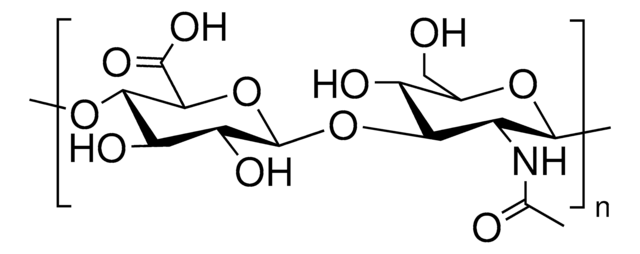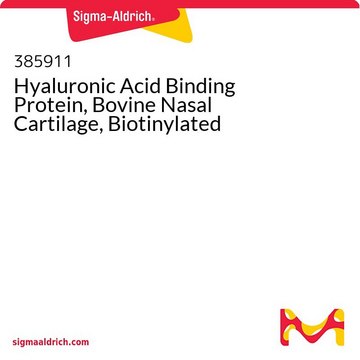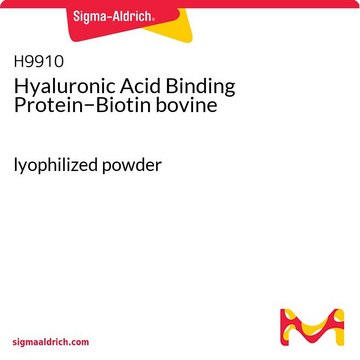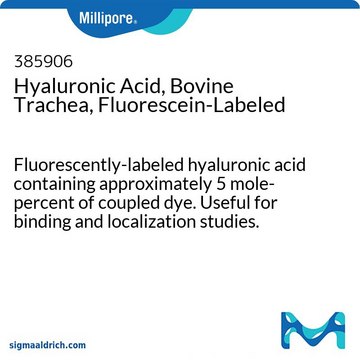B1557
Hyaluronan biotin sodium salt
≥97%, soluble powder
Sinonimo/i:
Hyaluronic acid biotin
Autenticatiper visualizzare i prezzi riservati alla tua organizzazione & contrattuali
About This Item
Prodotti consigliati
Livello qualitativo
Saggio
≥97%
Stato
soluble powder
PM
≥700 kDa
Perdita
≤5% loss on drying
Colore
white to tan
Temperatura di conservazione
2-8°C
Categorie correlate
Applicazioni
Hyaluronan biotin (HA-biotin) may be used as a specific bioaffinity probe to detect HA-binding proteins (hyaladherins), HA-receptors and HA-binding components in tissues and cells. Hyaluronan biotin may be used in the development of affinity binding systems for the immobilization and purification of hyaladherins. HA-biotin may be used in hydrogel development and for drug targeting.
Highly sensitive probe for detecting nanogram levels of hyaluronan binding proteins (hyaladherins).
Altre note
From cocks comb or fermentation.
Codice della classe di stoccaggio
11 - Combustible Solids
Classe di pericolosità dell'acqua (WGK)
WGK 3
Punto d’infiammabilità (°F)
Not applicable
Punto d’infiammabilità (°C)
Not applicable
Dispositivi di protezione individuale
Eyeshields, Gloves, type N95 (US)
Scegli una delle versioni più recenti:
Possiedi già questo prodotto?
I documenti relativi ai prodotti acquistati recentemente sono disponibili nell’Archivio dei documenti.
I clienti hanno visto anche
P Auvinen et al.
The American journal of pathology, 156(2), 529-536 (2000-02-10)
Hyaluronan (HA) is an extracellular matrix polysaccharide that promotes cell migration through its cell surface receptors and by effecting changes in the physical environment. HA expression is frequently increased in malignant tumors, whereas its association with the invasive potential and
T Pouyani et al.
Bioconjugate chemistry, 5(4), 370-372 (1994-07-01)
Hyaluronic acid (HA) is a linear polysaccharide composed of repeating disaccharide units of D-glucuronic acid (GlcUA) and N-acetyl-D-glucosamine (GlcNAc). Hyaluronate plays an important role in many biological processes as mediated by its interactions with a number of HA-binding proteins (the
D Liu et al.
Frontiers in bioscience : a journal and virtual library, 3, d631-d636 (1998-06-23)
CD44 is a cell surface glycoprotein present on many cell types. Many CD44 isoforms have been identified. All CD44 isoforms utilize identical transmembrane and cytoplasmic domains. The hematopoietic form of CD44 (CD44H) is the major CD44 protein present on normal
James Melrose et al.
Methods in molecular medicine, 101, 65-78 (2004-08-10)
Hyaluronan (HA) binding proteins (HABPs) were localized in cartilaginous ovine tissues (articular cartilage, intervertebral disc) using a biotinylated HA (bHA) oligosaccharide bioaffinity probe. The bHA oligosaccharide probe was prepared by partial digestion of HA with ovine testicular hyaluronidase, and the
Yuan Cui et al.
Applied biochemistry and biotechnology, 169(1), 239-249 (2012-11-28)
Hyaluronic acid is a naturally ionic polysaccharide with cancer cell selectivity. It is an ideal candidate material for delivery of anticancer agents. In this study, hyaluronic acid (HA) micro-hydrogel loaded with anticancer drugs was prepared by the biotin-avidin system approach.
Articoli
Glycosaminoglycans are large linear polysaccharides constructed of repeating disaccharide units.
Il team dei nostri ricercatori vanta grande esperienza in tutte le aree della ricerca quali Life Science, scienza dei materiali, sintesi chimica, cromatografia, discipline analitiche, ecc..
Contatta l'Assistenza Tecnica.
